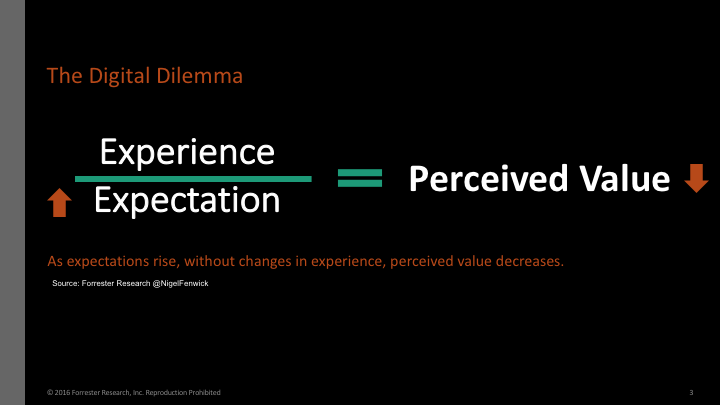How To Solve The Digital Dilemma
There’s a fundamental difference between companies that apply digital technology as a bolt-on (frequently adding an eCommerce site, social media, or customer mobile apps) and those that take a more holistic approach to transforming the way the company uses technology to deliver better customer outcomes and drive revenue.
Transformers are more likely to succeed because they recognize their customers’ expectations are evolving. The executives in these companies redesign their business to evolve alongside the expectations of their customers. These companies are obsessed with helping their customers achieve their desired outcomes, and they continuously explore new ways to do that profitably. This is why transformers are destined to become digital predators while bolt-on companies are more likely to become digital prey.
One of the distinguishing characteristics of many transformers that caught my attention back in 2013 remains a challenge for many companies in 2016: delivering digital operational excellence (DOX). DOX focuses on the ability to use emerging technologies to change operational aspects of the business (those not directly touching the customer) to create business agility in service of the customer. Why is this important? Because without the ability to evolve quickly, your company will fail. This is the digital dilemma.
I use this simple equation to illustrate my point:

Put simply, future revenue depends upon you being able to deliver to customers something of perceived value, for which your customers are willing to exchange something of value to your business, such as money, time, or data. The perceived value for each customer is unique and determined by the actual experience delivered (numerator) compared to the expectations that the customer has prior to the experience (denominator).
None of this is rocket science. It’s common sense. If the experience delivered – whether through a physical product, in-person service, or digital touchpoint – exceeds the expectation of the customer, the customer gets a heightened sense of value. But if their expectations are not met, then the customer has a diminished sense of value (see Digital’s Golden Rule). If we place a numeric value on experience and expectation, we can see this play out mathematically.
Now here’s the rub. Our expectations as human beings are no longer predominantly set by physical experiences and clever advertising. Our expectations are increasingly set and reset by our own digital experiences. And digital experiences transcend industries. When I get next-day delivery at home via Amazon, it resets my expectations for delivery from anyone. When my hotel allows me to select my room from a floor plan on my phone and check in before I arrive, my expectations on any self-service have been reset.
But what if you are not selling to consumers? What if your business is B2B?
It doesn’t matter!
Your customers are people. Some buy from Amazon. Some stay in hotels. Some fly. Some watch Netflix. And they all have new digital experiences almost every day of their lives. And each experience they have resets their expectations ever so slightly on what your company should be able to deliver. Go back to the equation: Their denominator is rising.
So what happens if your business delivers exactly the same experience today as it did last year – or even last month? Over time, the perceived value of your product/brand diminishes. And it continues to get lower and lower until at some point, the customer decides to switch to an alternative supplier.
This happens at different rates for every customer because our expectations evolve at different rates. So over time, you see more and more customers leave – or simply fail to renew their contract – and your business sees a decline in sales. At this point, most CEOs will double-down, focusing on cutting costs to protect margins. They trim out the innovation spending and focus on doing what the company does best. And they cut the technology spend. But sales will continue to decline because the business is not evolving in line with customer expectations.
By contrast, digital predators focus as much energy on DOX as they do on DCX (digital customer experience). They recognize that without world-class operations that enable business agility, they cannot continuously evolve their business in line with customer expectations.
To solve the digital dilemma, your company must master both DOX and DCX simultaneously.
In Unleash The Power Of Digital Operational Excellence (free to Forrester clients), I highlight six elements of DOX where digital predators outpace their peer group. And in my blog post on The 2016 Guide To Digital Predators, Transformers, And Dinosaurs, I go into greater analysis of the differences between digital predators and dinosaurs across both DCX and DOX.
If you’re struggling with moving beyond digital bolt-ons in your business, let me know. Is solving the digital dilemma a challenge for your company?
- Previous post: One Million Thanks!
- Next post: BMC Wants A Greater Share Of The Digital Economy